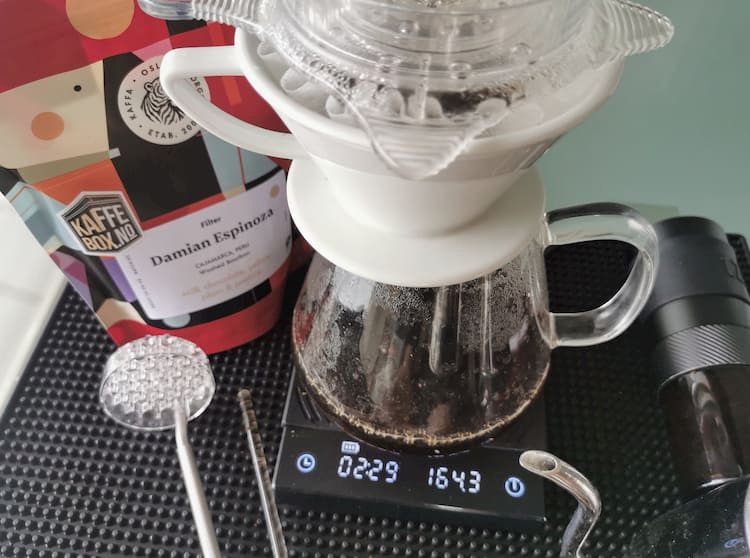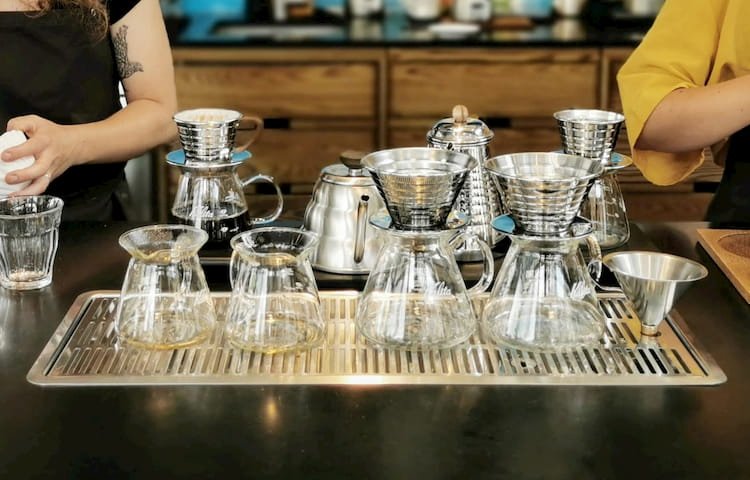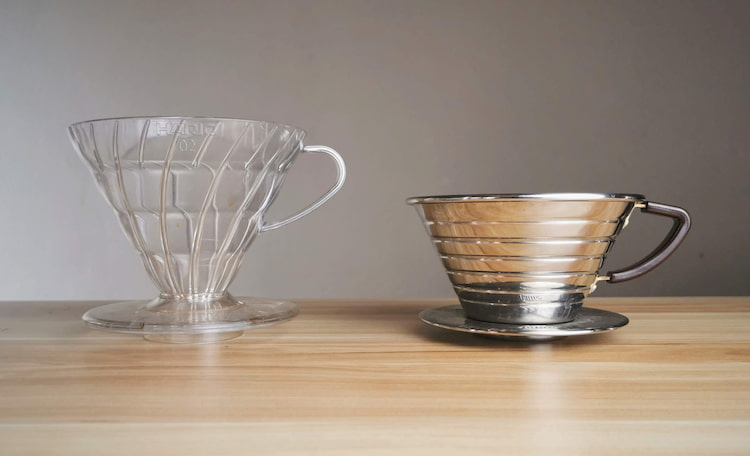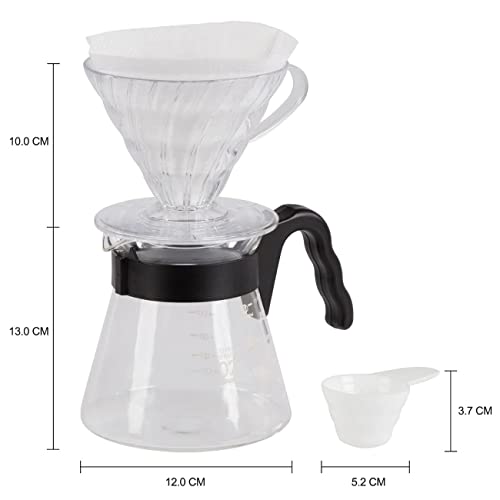In real life you can either be a dog or a cat person. It’s little bit the same in the world of coffee, where you’re either a fan of cone shaped or flat-bottom drippers.
Today, we’re going to do a review and comparison between two of the most beloved and well-known drippers; we are of course talking about no other than the iconic Hario V60 and the sleek Kalita Wave.
I’ll share my thoughts about their pros and cons, and by the end of this post, surely, you’ll get a better appreciation of which one you should consider buying.
Quick navigation
Hario V60: The backstory
Hario is an old company, and its brand name means “The King of Glass” in Japanese.
Hario has a wide range of beautiful coffee products. The Buono kettle and range server are examples of this exquisite design language.
It’s a bit ironic that they became so known for their cone-shaped dripper, since it was actually a small coffee company named Kono, who invented the design in the 1970’s.
Hario V60 was first introduced in its native Japan, but it didn’t get popular in the West until around 2010.
Around that time specialty coffee started to take off, and the V60 quickly became almost synonymous with this type of coffee.
Oh, by the way, I have made a video to help you decide 👇
Kalita Backstory
Kalita is another well-known Japanese coffee company. Actually, Kalita started out as an imitator of the old school German coffee Melitta (hence the similar names), but eventually they grew into their own.
You can still buy Melitta-style knock-off drippers produced by Kalita.
However, the Kalita Wave is definitely a striking and unique design that we have to give the company some credit for.
Shortly after the Hario V60 had paved the way in specialty coffee shops around the world, attention shifted to the flat-bottomed rival.
For some reason, Hario got a reputation for being a little bit fussy and unpredictable. You couldn’t be sure that you’d get the same coffee every time. Whereas the Kalita Wave was seen as a steadier and more consistent way of brewing due to its flat-bottom design.
Hario v60 vs Kalita wave: Key differences
There are a couple of crucial differences between the Hario V60 and the Kalita Wave. Let’s dive into them:
- Drain Hole
Hario V60 has one big hole where all the water has to go through, whilst the Kalita Wave has three smaller holes that restrict the flow rate.
In theory this means that there will be more flow restriction with the Kalita Wave. So you can get away with a more careless pouring technique.
- Shape: Cone vs Flat-bottom
Hario V60 has a 60-degree angle, and it’s cone-shaped. You could get the impression that the coffee at the bottom of the dripper would get over-extracted, but the coffee on top of the dripper would get under-extracted because of the shape.
Kalita Wave has a flat bottom. Some coffee people think that the flat bottom makes the brew more consistent compared to cone-shaped brewers because no parts of the coffee is in contact with water for extended periods.
Personally, I think the debacle around cone-shaped drippers is somewhat of a non-issue. if you look how water extracts coffee, I think there’s a good argument to be made that water is a more efficient solvent when it hits the brew bed at first and it doesn’t have coffee particles already and then it extracts less efficiently as it makes its way down and becomes more saturated with coffee particles and loses some thermal energy. So, in that sense, a cone-shape would be rather helpful.
- Filters
I love Hario V60’s cone-shaped filters. Nowadays, many more brands produce the cone-shaped filter, but I find that some don’t have the best quality. Unfortunately, Hario doesn’t even create good filters anymore. They used to make some excellent filters, but then they changed factory, and the quality hasn’t been the same ever since.
I personally prefer the brand called ‘CAFEC’ which makes a series of different cone-shaped filters. The one using a material called ‘abaca’ guarantees a predictable flow rate and a delicious cup and.
Kalita Wave has wave-shaped filters. That’s actually how it got its name because the filters are shaped like a wave. The wave shape will help push the brew bed and the water away from the sides of the dripper and will actually help with the thermal retention of the brew bed. One thing to keep in mind is that it’s a bit harder to find Kalita filters; not many brands produce this type.
Is Kalita Wave more consistent?
As I have mentioned before on the blog, the flow rate is pretty different across the various Kalita Wave models. For instance, the glass and the ceramic version are a lot faster than the steel version.
The stainless-steel version is probably the most well-known Kalita Wave, and it’s the model that has the least predictable flow rate.
A common criticism, particularly with the steel Kalita Wave is that the filters tend to clog the drain holes.
The ribs in the bottom of the stainless-steel version don’t do a good job of pushing the filter away from the holes.
With the stainless-steel version, it’s very easy for the filter to get dragged down, and once it blocks one of the drain holes, it completely changes the game.
The ceramic, sandstone, glass and Tsubame versions don’t have the same problem.
Kalita Wave Rankings – According to The Coffee Chronicler
- Ceramic Kalita Wave: 4.7/5
- Tsubame Steel: 4.5/5
- Sandstone / Sagan: 4.2/5
- Glass: 4.0/5
- Stainless Steel: 2.5/5

A nice little trick that I’ve been using is adding a dispersion screen from the Flair Pro espresso maker to the bottom of the brewer, which helps to make it more consistent. It will lift the filter and avoid the clogging issue. It’s relatively cheap and works like a charm
Consistency?
So which of the two is more consistent: is it the Kalita Wave or the Hario V60?
The question becomes hard to answer because there are so many different Kalita Wave versions, and they all have some differences.
If we’re talking about all of the Kalita-models besides the stainless steel version, I think they are quite consistent.
But if we’re talking about the stainless-steel version, I don’t think it makes sense to say that it’s more reliable than the V60..
And as mentioned, though the stainless-steel version is the most popular Kalita Wave.
At least with the Hario V60 – you know what to expect, and you’re going to get it.
If you choose either the ceramic, plastic, or one of the metal versions, the difference will not be significant with Hario V60.
Both of these brewers can make a delicuiys coffee, but they do have a bit different flavor profile.

Hario V60 vs Kalita Wave: the Verdict
I think beginners should go for the V60.
With the V60, you get a longer aftertaste, a bit more of an interesting acidity, and some interesting texture. It somehow elevates slightly inferior beans and makes them more interesting.
Even if you don’t have the best grinder, or your technique is not the best, you can get some very tasty and interesting results.
With the Kalita Wave, however, you tend to get more uniform cups with more clarity, transparency, and elegance.
However, you need to be knowledgeable about what you’re doing. If you don’t have a great grinder, I think it’s hard to get the best out of the Kalita Wave.
Once you’re a bit experienced, know more about coffee, different beans, and brewing styles, you can upgrade to the Wave. And when you get to that point, don’t forget to check out my foolproof Kalita Wave pour over method!
What material?
- I personally like to brew with the plastic V60 simply because it’s robust, even if it’s dropped on the floor, it will survive. But if you prefer the other versions, there’s no reason you shouldn’t go for it. Just remember that they do need a little bit more preheating compared to the plastic ones.
- It’s a little bit more challenging with the Kalita Wave. I like to brew on the glass version, but it’s exceptionally fragile, so I suggest getting the ceramic version. It will need a bit more preheating, but you can get delicious coffee with it. If you specificually want a steel Kalita, I think it makes sense to splurge and go for the Tsubame model. It’s a lot more reliable than its more affordable steel-sibling, and it’s even more beautiful.
FAQ
I think beginners should start with a Hario V60. When you have more experience with pour over coffee and better sense of extraction, then you should proceed and get a ceramic Kalita Wave
No, I don’t think that the Kalita Wave is easier to use than the V60. However, you can get away with using a more simple pouring technique with the Kalita Wave. On the other hand, it might be easier to create a complex cup with the V60. For all differences, click the article above.
Yes, it’s actually possible to use Kalita filters in a V60, even though they are not made for it. You will get a very fast flow rate, which might be beneficial with some very light roast coffees.
No, the Hario V60 isn’t that difficult to use. As long as you have a gooseneck kettle and bit of patience, you can quickly get excellent results. Check out, my free specialty coffee guide, if you want to find out what’s important.

